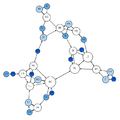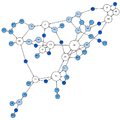Definition
The term sociometry relates to its Latin etymology, socius meaning companion, and metrum meaning measure. Jacob Moreno defined sociometry as "the inquiry into the evolution and organization of groups and the position of individuals within them." He goes on to write "As the ...science of group organization, it attacks the problem not from the outer structure of the group, the group surface, but from the inner structure". [1] "Sociometric explorations reveal the hidden structures that give a group its form: the alliances, the subgroups, the hidden beliefs, the forbidden agendas, the ideological agreements, the "stars" of the show. [2] "
Moreno developed sociometry as one of the newly developing social sciences. He states: "The chief methodological task of sociometry has been the revision of the experimental method so that it can be applied effectively to social phenomena." (Moreno, 2012:39) [3]
The practice of the method had the focus on the outcomes established by the participants: "By making choices based on criteria, overt and energetic, Moreno hoped that individuals would be more spontaneous, and organisations and groups structures would become fresh, clear and lively."
One of Moreno's innovations in sociometry was the development of the sociogram, a graph that represents individuals as points/nodes and the relationships between them as lines/arcs. [4] Moreno, who wrote extensively of his thinking, applications and findings, also founded a journal entitled Sociometry.
- Moreno's sociograms
- 1st Grade
- 2nd Grade
- 3rd Grade
- 4th Grade
- 5th Grade
- 6th Grade
- 7th Grade
- 8th Grade
Within sociology, sociometry has two main branches: research sociometry, and applied sociometry. Research sociometry is action research with groups exploring the socio-emotional networks of relationships using specified criteria e.g. Who in this group do you want to sit beside you at work? Who in the group do you go to for advice on a work problem? Who in the group do you see providing satisfying leadership in the pending project? Sometimes called network explorations, research sociometry is concerned with relational patterns in small (individual and small group) and larger populations, such as organizations and neighborhoods. Applied sociometrists utilize a range of methods to assist people and groups review, expand and develop their existing psycho-social networks of relationships. Both fields of sociometry exist to produce through their application, greater spontaneity and creativity of both individuals and groups.







